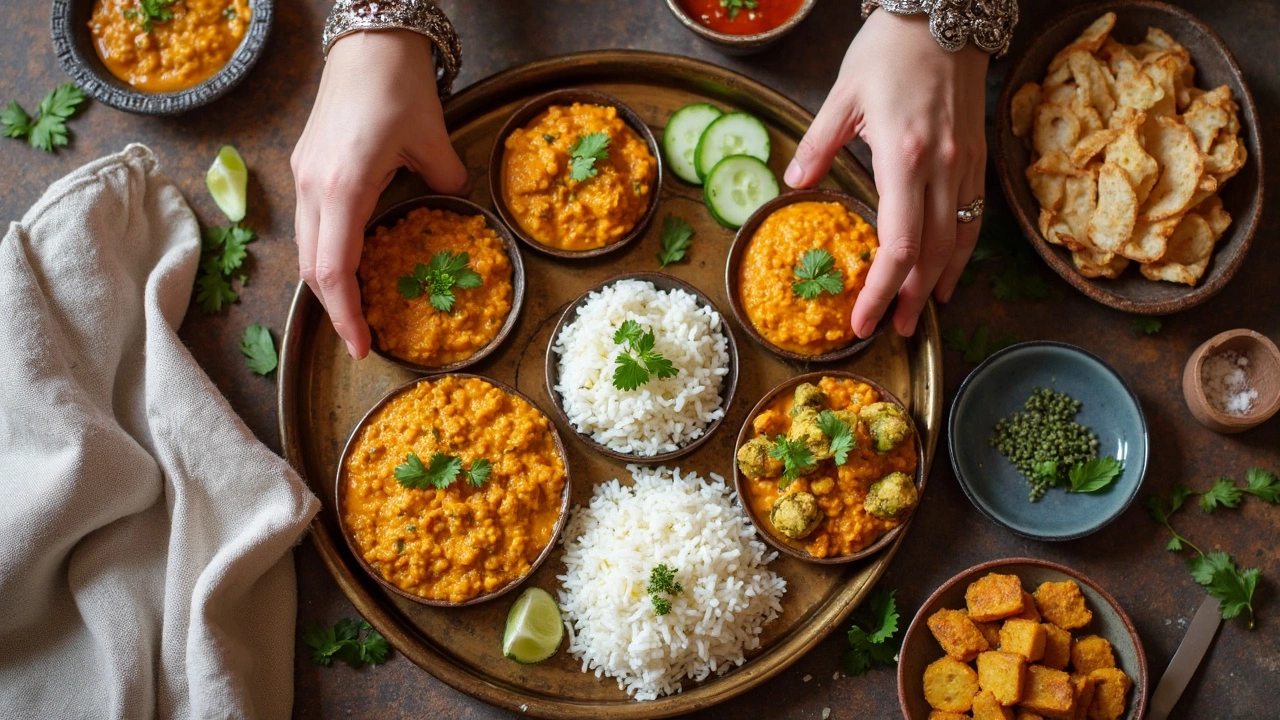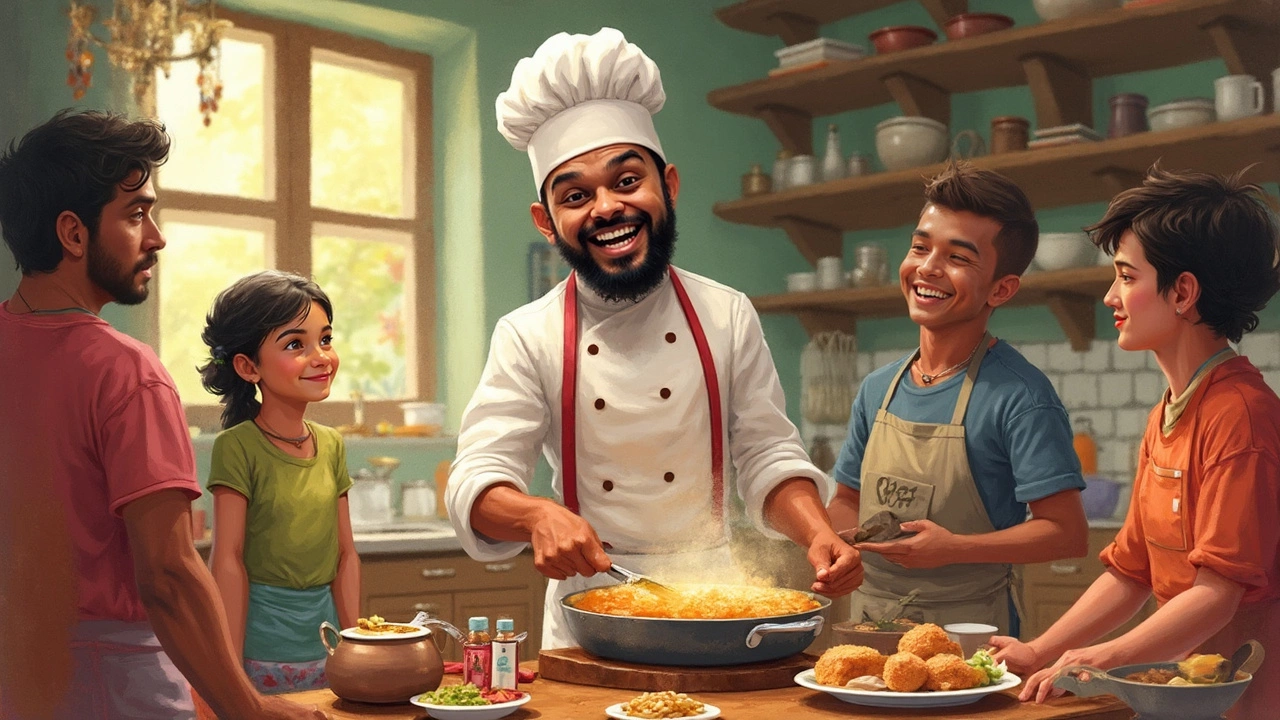Think Indian food, and you probably jump straight to thoughts of burning-hot curries and fiery flavors. But here's the big secret: Indian kitchens turn out dishes for every spice level, including the super mild ones that won't leave you reaching for a glass of milk.
If spicy food isn't your thing, you don't have to miss out on Indian flavors. Plenty of traditional recipes keep things gentle, focusing on richness and comfort instead of heat. Some of the best-loved Indian meals across homes and restaurants are actually pretty mild, with just a hint of spice for flavor, not for scorch.
It's not just about the chili count. Indian cooking packs in taste through fresh herbs, subtle spices, and creamy elements like yogurt or coconut milk. That means you can get all the depth without sweating bullets at dinner. Want to eat Indian but worried about the spice? Stick around—I'll show you the safest picks, why they're so gentle, and how to ask for 'no heat' the right way.
- Why Not All Indian Food is Spicy
- Classic Mild Indian Dishes You Should Know
- Tips for Keeping Indian Food Mild at Home
- How to Order Mild at Indian Restaurants
- Extra Tricks to Enjoy Indian Food Without the Burn
Why Not All Indian Food is Spicy
Contrary to what people outside India sometimes think, not every plate that comes out of an Indian kitchen is packed with chilies. India’s food is more about variety than pure heat. From north to south and east to west, the flavor profiles change, and a lot of mild Indian food takes the spotlight in homes every day.
If you look at Indian cooking, the main goal is layering flavors, not just burning your tongue. Most families cook for everyone at the table—kids, grandparents, and people who don’t want their meal too spicy. Many classic recipes use ingredients like yogurt, cream, milk, coconut, or simply more vegetables to soften any heat. Region also plays a big role. Northern dishes often have cream and nuts, making them rich and gentle. Down south, yes, some dishes are hot, but you’ll also find plenty that’s mellow, like coconut-based stews.
Some basics to remember:
- Fresh herbs (like cilantro and mint) add flavor, not fire.
- Spices like cumin, coriander, and turmeric bring color and taste without heat.
- Easy Indian dishes like dal (lentil stew) or korma are naturally low on chili.
If you want numbers, Indians actually eat more mild to moderate food at home than what’s served in the average restaurant outside the country. Most of the extra spice is added to cater to what tourists think Indian food should taste like.
| Region | Common Heat Level | Famous Mild Dish |
|---|---|---|
| North India | Mild to Medium | Paneer Butter Masala |
| West India | Mild to Medium | Gujarati Dal |
| South India | Mild and Hot (varies) | Vegetable Stew |
| East India | Mild | Chingri Malai Curry |
So, if you’re looking for the least spicy Indian dish, you’re definitely in the right country. The trick is to know what to pick—and there’s a whole world of gentle, flavorful options to try.
Classic Mild Indian Dishes You Should Know
If you're hunting for the least spicy Indian dish, start with these tried-and-true picks. Almost every Indian household has their own versions, but the base flavors stay gentle and easy on the taste buds.
- Dal Tadka/Dal Fry: This is yellow lentils cooked until creamy, seasoned with just a little cumin and turmeric. The heat level? Barely there. It's pure comfort food, especially with rice or simple flatbread.
- Paneer Butter Masala: Soft cottage cheese cubes in a thick, buttery tomato sauce. It's naturally sweetish and rich, and most recipes use only a sprinkle of chili—if any. If you're ordering out, just ask for 'mild.'
- Navratan Korma: This dish is loaded with vegetables and a cashew or cream-based sauce. The focus is on nutty flavors, gentle spices, and sweetness from veggies and raisins.
- Chicken Korma: If you want meat, go for this classic. Boneless chicken simmers in a smooth, mild sauce made with yogurt and nuts. Usually, chili is almost absent, but the taste is luxurious and satisfying.
- Curd Rice (Thayir Sadam): This South Indian staple is as basic and non-spicy as they come—just rice mixed with yogurt, sometimes with a tiny tempering of mustard seeds for crunch.
- Vegetable Pulao: A light, fragrant rice dish cooked with mild spices, peas, and carrots. Absolutely no chilies unless you want them, and it works as a meal or a side.
To help compare, check out the average chili content in these dishes (based on popular home recipes):
| Dish | Average Chili Amount |
|---|---|
| Dal Tadka | 1/4 tsp (optional) |
| Paneer Butter Masala | 1/4 tsp (often skipped) |
| Navratan Korma | None |
| Chicken Korma | 1/4 tsp (optional) |
| Curd Rice | None |
So if you’re ordering Indian takeout or cooking at home, these are the safest bets. Remember—if you're ever in doubt, say 'no chilies' and you'll almost always get a super mild meal.

Tips for Keeping Indian Food Mild at Home
Cooking least spicy Indian dish recipes at home is way easier than most people think. The trick is knowing which ingredients to limit or swap out. You can totally skip the dried red chilies or the green chilies—both are main heat boosters in a ton of Indian dishes. Don’t worry, it won’t ruin the meal. Most of the flavor actually comes from a mix of onions, garlic, ginger, tomatoes, and spices like cumin, coriander, turmeric, and cardamom. None of those are spicy on their own.
Yogurt, cream, or coconut milk make fantastic partners for keeping things mellow. They not only cool down the overall flavor but also make the dish creamy. If you’re making something like korma, paneer butter masala, or dal, try adding a little extra of these gentle ingredients to tone things down.
- Always taste as you go. Don’t just dump all your ground spices in at once. Add, taste, then add more only if you really want richer flavor (never for heat).
- Swap out garam masala for simple spices. Garam masala sometimes has black pepper, which can sneak up on your taste buds. Just stick to cumin, coriander, or turmeric if you want to be extra safe.
- If a recipe calls for chili powder, switch it out for paprika (which delivers color, not heat). Or leave it out entirely—won’t hurt anything.
- To give dishes flavor without fire, lean into fresh herbs like cilantro or mint at the end. This adds a pop of green, not burn.
- Feeling worried you’ll goof up? Start with small-batch recipes so you’re not stuck with a big spicy pot. Adjust as needed before scaling up next time.
Check out this quick comparison of common Indian spices and their heat levels. You’ll see, plenty of classics bring zero heat to your table.
| Spice | Heat Level |
|---|---|
| Cumin | None |
| Coriander | None |
| Cardamom | None |
| Turmeric | None |
| Paprika | Very Mild |
| Black Pepper | Low to Mild |
| Chili Powder | Medium to Hot |
| Red/Green Chili | Hot |
Sticking with mild Indian food doesn’t mean you have to lose out on the authentic flavors. Just steer clear of chili, go heavy on aromatics and mellow spices, and you’ll enjoy tasty, family-friendly meals every time.
How to Order Mild at Indian Restaurants
Trying Indian food at a restaurant but don’t want your tastebuds set on fire? You’re not alone. The good news is, almost every Indian spot has least spicy Indian dish options—if you know what to ask for. The trick is communication and picking the right dishes. Here’s how you can eat safely, even if you have zero spice tolerance.
First, don’t hesitate to be direct with your server. Mention that you want your meal mild, or even "no chili at all." Most restaurants in and outside India totally get this request—they're used to it. Some kitchens can even adjust a mild dish to be extra mild, if you ask early enough.
Look for these mild Indian food classics on the menu:
- Butter chicken or chicken makhani – This is a creamy, tomato-based dish. It’s popular for its gentle flavor and mild heat, thanks to butter and cream.
- Korma – Whether it’s chicken, lamb, or veggie, korma uses yogurt and nuts for a naturally mild, rich sauce.
- Dal makhani – Lentils slow-cooked with cream and butter, almost always easy-going on the spice.
- Navratan korma – A vegetarian curry loaded with veggies, mild sauce, and often fruit or nuts for sweetness.
- Paneer butter masala – Soft cheese in a creamy, low-spice sauce.
If the menu says "spicy" or "hot," skip it unless you’re ready for some heat. Dishes with "vindaloo," "madras," or "chettinad" in the name usually lean extra hot, so they’re best avoided if you want mild Indian food.
A little insider tip—restaurants catering to Western customers often offer a "mild, medium, or spicy" heat level option. If unsure, say you want it "not spicy" or "kids' level spice." You can ask for sides of raita (yogurt sauce) or cucumber salad to cool things down if the dish surprises you.
For the curious, here are dishes and their typical chili level on a simple scale:
| Dish | Spice Level (1-5) |
|---|---|
| Butter Chicken | 1 |
| Korma | 1 |
| Dal Makhani | 1-2 |
| Tikka Masala | 2 |
| Vindaloo | 5 |
Don’t be shy about your preference. People ask for less spice all the time. Even if the dish comes out with a little tingle, adding plain rice or naan makes any meal feel milder. Go for creamier gravies, anything with "butter" or "korma," and you’ll likely find your safe spot in easy Indian recipes heaven.

Extra Tricks to Enjoy Indian Food Without the Burn
Don’t let the fear of heat keep you away from mild Indian food. With a few simple moves, you can dive into Indian cuisine and keep things totally comfortable for your taste buds.
The first step is knowing where the spice comes from. In Indian cooking, it's often green chilies, red chili powder, black pepper, or sometimes spicy pickles on the side. If you’re cooking at home, just skip these. You’ll still get tons of flavor thanks to all the other spices—cumin, coriander, turmeric, cinnamon, and more.
At restaurants, don’t be shy. Tell your server you want your food “not spicy at all” or “very mild.” In most places, that’s totally normal. If you see something called “korma,” “makhani,” or “malai” on the menu, those are usually the least spicy Indian dishes. Steer clear of “vindaloo” and “madras” if you’re sensitive—they’re loaded with heat.
What to do if the dish turns out hotter than expected? You’ve got options. Ask for a side of yogurt (a.k.a. raita), cream, or even plain rice. All these cool things tone down the burn. Did you know that a glass of milk or lassi works way better than water to calm your mouth? It’s because the milk protein breaks up spicy oils that water can’t touch.
If you cook at home, here are a few must-try tricks:
- Add more coconut milk or cream to sauces—super creamy, super mild.
- Mash in a boiled potato or some paneer if a curry ends up too spicy—they soak up chili fast.
- Always taste as you go. Spices build up over time. Start slow.
- Serve your food with a side of naan or rice; carbs help mellow out the flavors.
Not sure which brands or ready-made sauces are safe bets in the store? Some major supermarkets now put a “heat scale” or chili icon on packaging, so check labels when you shop for easy Indian recipes.
Want the hard numbers on why this all works? Here’s a handy chart to keep in mind:
| Food or Drink | Spice-Soothing Power |
|---|---|
| Yogurt/Lassi | Excellent – instantly calms heat |
| Rice/Naan | Very Good – absorbs sauces, reduces spice |
| Cucumber | Good – cools mouth quickly |
| Water | Poor – spreads spice, doesn't help |
With tricks like these, there’s no need to stress. Beginner Indian cuisine can taste amazing without giving your tongue a workout.
